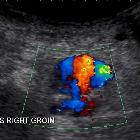femoral artery pseudoaneurysm







Femoral artery pseudoaneurysms are usually iatrogenic, as the femoral artery is the vessel of choice for most endovascular arterial interventions.
Pathology
Etiology
- iatrogenic
- anticoagulation therapy
- inadequate compression following femoral arterial puncture for endovascular intervention
- improper arterial puncture technique: ideally the common femoral artery should be punctured
- inadvertent femoral artery branch puncture
- post surgical
- intravenous drug use
- penetrating trauma
Radiographic features
Pseudoaneurysms generally appear as rounded sacs in close proximity to, and often with, a connecting "neck" from the parent vessel. The internal appearance of the sac is variable, depending on the degree of thrombosis. Partial rupture of the pseudoaneurysm may lead to a complex (multilobed) configuration, with multiple interconnected sacs (see Case 6). Complete rupture may lead to more diffusely infiltrative hematoma.
Ultrasound
Ultrasound is the quickest and best modality for assessment. Due to the turbulent forward and backwards flow, a characteristic yin-yang sign may be seen on color flow while a "to-and-fro" pattern may be seen with pulsed Doppler. Ultrasound can also be used for therapeutic probe compression (ultrasound-guided compression), providing real-time feedback of the thrombosing pseudoaneurysm.
CT
Unenhanced CT scans may demonstrate a low-attenuation rounded structure arising from the donor artery. Intermediate or high attenuation (hemorrhage) adjacent to the pseudoaneurysm may be seen and indicates rupture, which may vary in attenuation dependent on being chronic or acute. The pseudoaneurysm wall is usually smooth and well-defined except in a mycotic pseudoaneurysm, where the wall can be thickened, irregular, or ill-defined.
CT angiography
CT angiography may demonstrate a contrast-filled sac. The non-enhancing low-attenuation area within the pseudoaneurysm sac indicates partial thrombosis . Communication with a donor artery adjacent to the pseudoaneurysm can usually be seen.
Treatment and prognosis
Treatment options include
- surgical repair
- ultrasound-guided compression
- ultrasound-guided thrombin injection
- endovascular therapy: stent-graft placement
At the time of writing, the success rate of thrombin injection (89-96%) is considered to be much higher than with compression (74-78%) .
See also
Siehe auch:
- Aneurysma spurium
- Aneurysma spurium der Arteria profunda femoris
- yin-yang sign
- Komplikationen Angiographie
und weiter:

 Assoziationen und Differentialdiagnosen zu femoral artery pseudoaneurysm:
Assoziationen und Differentialdiagnosen zu femoral artery pseudoaneurysm:

